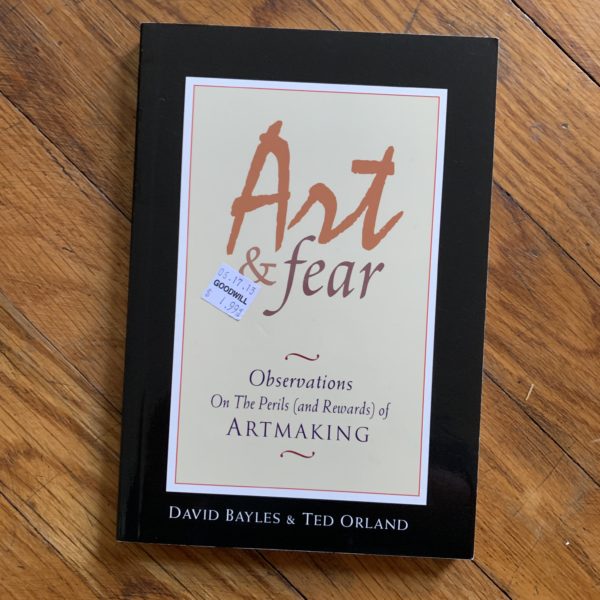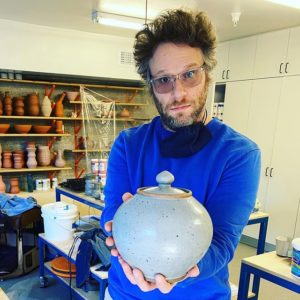One of my favorite parables about creative work comes from David Bayles and Ted Orland’s book, Art & Fear:
[A] ceramics teacher announced on opening day that he was dividing the class into two groups. All those on the left side of the studio, he said, would be graded solely on the quantity of work they produced, all those on the right solely on its quality. His procedure was simple: on the final day of class he would bring in his bathroom scales and weigh the work of the “quantity” group: fifty pound of pots rated an “A”, forty pounds a “B”, and so on. Those being graded on “quality”, however, needed to produce only one pot — albeit a perfect one — to get an “A”. Well, came grading time and a curious fact emerged: the works of highest quality were all produced by the group being graded for quantity. It seems that while the “quantity” group was busily churning out piles of work – and learning from their mistakes — the “quality” group had sat theorizing about perfection, and in the end had little more to show for their efforts than grandiose theories and a pile of dead clay.
Like any great parable, it’s the specificity of image that makes it work for me: You can picture the dusty pottery studio, the scales, weighing all the crummy pots and failed experiments.
It makes me think of the actor Seth Rogen, who joined a pottery studio with his wife last year and has been showing his work by posting pictures of his creations on Instagram:
So it was puzzling to me a few months ago when I read James Clear’s Atomic Habits and he retold the parable, but using a photography class:
ON THE FIRST day of class, Jerry Uelsmann, a professor at the University of Florida, divided his film photography students into two groups.
Everyone on the left side of the classroom, he explained, would be in the “quantity” group. They would be graded solely on the amount of work they produced. On the final day of class, he would tally the number of photos submitted by each student. One hundred photos would rate an A, ninety photos a B, eighty photos a C, and so on.
Meanwhile, everyone on the right side of the room would be in the “quality” group. They would be graded only on the excellence of their work. They would only need to produce one photo during the semester, but to get an A, it had to be a nearly perfect image.
At the end of the term, he was surprised to find that all the best photos were produced by the quantity group. During the semester, these students were busy taking photos, experimenting with composition and lighting, testing out various methods in the darkroom, and learning from their mistakes. In the process of creating hundreds of photos, they honed their skills. Meanwhile, the quality group sat around speculating about perfection. In the end, they had little to show for their efforts other than unverified theories and one mediocre photo.
 “What in the hell?” I thought. Why would you move from something like pottery, which is more concrete, to photography, which is more abstract? (What makes a photo good is more subjective than what makes a pot good — you can still hang a blurry photo in a gallery, but you can’t drink out of a cracked mug.)
“What in the hell?” I thought. Why would you move from something like pottery, which is more concrete, to photography, which is more abstract? (What makes a photo good is more subjective than what makes a pot good — you can still hang a blurry photo in a gallery, but you can’t drink out of a cracked mug.)
Then I noticed an asterisk at the end of Clear’s telling and checked the endnotes. Turns out he had emailed with Ted Orland in 2016, and learned the true origin of the parable:
“Yes, the ‘ceramics story’ in ‘Art & Fear’ is indeed true, allowing for some literary license in the retelling. Its real-world origin was as a gambit employed by photographer Jerry Uelsmann to motivate his Beginning Photography students at the University of Florida. As retold in ‘Art & Fear’ it faithfully captures the scene as Jerry told it to me—except I replaced photography with ceramics as the medium being explored. Admittedly, it would’ve been easier to retain photography as the art medium being discussed, but David Bayles (co-author) & I are both photographers ourselves, and at the time we were consciously trying to broaden the range of media being referenced in the text. The intriguing thing to me is that it hardly matters what art form was invoked—the moral of the story appears to hold equally true straight across the whole art spectrum (and even outside the arts, for that matter).”
(Ted Orland, by the way, was an assistant to Ansel Adams.)
Regardless of the form of the parable, the moral has certainly been true with my own work, especially writing and blogging. The frequency of my work — showing up at regular intervals, without worrying about results — has actually lead to better results.
Quantity leads to quality.
Related reading: Something small, every day, the John Cage parable that changed my life




